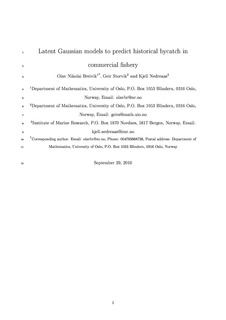| dc.contributor.author | Breivik, Olav Nikolai | |
| dc.contributor.author | Storvik, Geir Olve | |
| dc.contributor.author | Nedreaas, Kjell Harald | |
| dc.date.accessioned | 2017-12-14T13:31:47Z | |
| dc.date.available | 2017-12-14T13:31:47Z | |
| dc.date.created | 2016-10-03T13:01:19Z | |
| dc.date.issued | 2017 | |
| dc.identifier.citation | Fisheries Research. 2017, 185 62-72. | |
| dc.identifier.issn | 0165-7836 | |
| dc.identifier.uri | http://hdl.handle.net/11250/2471902 | |
| dc.description.abstract | Knowledge about how many fish that have been killed due to bycatch is an important aspect of ensuring a sustainable ecosystem and fishery. We introduce a Bayesian spatio-temporal prediction method for historical bycatch that incorporates two sources of available data sets, fishery data and survey data. The model used assumes that occurrence of bycatch can be described as a log-linear combination of covariates and random effects modeled as Gaussian fields. Integrated Nested Laplace Approximations (INLA) is used for fast calculations. The method introduced is general, and is applied on bycatch of juvenile cod (Gadus morhua) in the Barents Sea shrimp (Pandalus borealis) fishery. In this fishery we compare our prediction method with the well known ratio and effort methods, and make a strong case that the Bayesian spatio-temporal method produces more reliable historical bycatch predictions compared to existing methods. | |
| dc.language.iso | eng | |
| dc.relation.uri | http://publications.nr.no/1508504026/HistoricalBycatch-OlavNikolaiBreivik.pdf | |
| dc.title | Latent Gaussian models to predict historical bycatch in commercial fishery | |
| dc.type | Peer reviewed | |
| dc.type | Journal article | |
| dc.description.version | acceptedVersion | |
| dc.source.pagenumber | 62-72 | |
| dc.source.volume | 185 | |
| dc.source.journal | Fisheries Research | |
| dc.identifier.doi | 10.1016/j.fishres.2016.09.033 | |
| dc.identifier.cristin | 1388983 | |
| cristin.unitcode | 7431,16,0,0 | |
| cristin.unitname | Fiskeridynamikk | |
| cristin.ispublished | true | |
| cristin.fulltext | postprint | |
| cristin.qualitycode | 1 | |
